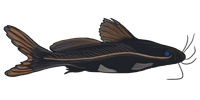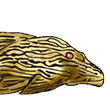Could it be some kind of large predatory characin, Hoplias? Heard of any squeeking tetras?
Bagre?
Bagre?
I work part-time at an LFS. One of our customers have recently been on a trip to Brazil. Today he told me about a fish that he had caught there, that the local people called "Bagre". He described it as "rather elongated and slim" "camoflague pattern" and "very sharp spines in the pectoral (as i understood it) fins". Oh, and that it made a squeeking sound when handled. Swedish is not his first language (he speaks portuguese) so i may have misunderstood him on some details. He also showed me a very blurry (loch ness - type  ) photo of it. On that photo it kind of reminded me of some type of Channa. I know that snakeheads aren't native to south america, any ideas?
) photo of it. On that photo it kind of reminded me of some type of Channa. I know that snakeheads aren't native to south america, any ideas?
Could it be some kind of large predatory characin, Hoplias? Heard of any squeeking tetras?
Could it be some kind of large predatory characin, Hoplias? Heard of any squeeking tetras?
- Jools
- Expert
- Posts: 16274
- Joined: 30 Dec 2002, 15:25
- My articles: 198
- My images: 941
- My catfish: 237
- My cats species list: 87 (i:235, k:1)
- My aquaria list: 21 (i:13)
- My BLogs: 7 (i:10, p:167)
- My Wishlist: 23
- Spotted: 450
- Location 1: Middle Earth,
- Location 2: Scotland
- Interests: All things aquatic, Sci-Fi, photography and travel. Oh, and beer.
- Contact:
Bagre simply means catfish (or old hag if IIRC), so no help there. My money is on a pimelodid or doradid, but without your picture you're very unlikely ever to find out what it is.
Can you scan or take a digi cam picture of the "loch ness" picture and post it?
Jools
Can you scan or take a digi cam picture of the "loch ness" picture and post it?
Jools
Last edited by Jools on 08 Feb 2005, 20:32, edited 1 time in total.
Owner, AquaticRepublic.com, PlanetCatfish.com & ZebraPleco.com. Please consider donating towards this site's running costs.
- Silurus
- Posts: 12461
- Joined: 31 Dec 2002, 11:35
- I've donated: $12.00!
- My articles: 55
- My images: 896
- My catfish: 1
- My cats species list: 90 (i:1, k:0)
- Spotted: 428
- Location 1: Singapore
- Location 2: Moderator Emeritus
- coelacanth
- Posts: 880
- Joined: 31 Dec 2002, 13:19
- My articles: 1
- My images: 2
- My catfish: 4
- My cats species list: 32 (i:3, k:0)
- Spotted: 3
- Location 1: Bolton, UK
- Location 2: UK
- Interests: All things Aquatic
- Shane
- Expert
- Posts: 4646
- Joined: 30 Dec 2002, 22:12
- My articles: 69
- My images: 162
- My catfish: 75
- My cats species list: 4 (i:75, k:0)
- My aquaria list: 5 (i:5)
- Spotted: 99
- Location 1: Tysons
- Location 2: Virginia
- Contact:
Actually, siluro means catfish, but it is not a word known by many people. Bagre does and does not mean catfish. A bagre would be what most people think of as a catfish. Something naked (no scales/armor) and with whiskers. In South America this means pims and auchenipterids (including ageneiosids). A doradid might be a bagre if it lacked strong armor, but if the scutes are well developed it would be a sierra (saw). (On an unrelated note, sierra can also be a mountain range (think of teeth on a saw) thus the Sierra Nevada, where I was raised, is the "snow covered saw").
It is important thus to understand that Panaque nigrolineatus is a panaque, Hemiloricaria caracensis a tabla (board), and Farlowella mariaelenae an aguje (needle), but if you suggest that a panaque, tabla or aguje is also a bagre, people would think you were mildly retarded to confuse such different fishes.
These terms are pretty much restricted to places that have lots of various catfish species (basically Panama and south). None of these words mean anything in Mexico for example. I have noticed that the Spanish (meaning from Spain) aquarium magazine "Acuario Practico" and the Mexican magazine "Aqua Guia" use the term pez gato (literally fish-cat). This is clearly just a translation of the English and/or French terms. I am not a language purist, but it seems sad to me that they have adopted this term when Spanish is already so rich in words for different catfishes.
OK, enough ethnotaxonomy....
-Shane
It is important thus to understand that Panaque nigrolineatus is a panaque, Hemiloricaria caracensis a tabla (board), and Farlowella mariaelenae an aguje (needle), but if you suggest that a panaque, tabla or aguje is also a bagre, people would think you were mildly retarded to confuse such different fishes.
These terms are pretty much restricted to places that have lots of various catfish species (basically Panama and south). None of these words mean anything in Mexico for example. I have noticed that the Spanish (meaning from Spain) aquarium magazine "Acuario Practico" and the Mexican magazine "Aqua Guia" use the term pez gato (literally fish-cat). This is clearly just a translation of the English and/or French terms. I am not a language purist, but it seems sad to me that they have adopted this term when Spanish is already so rich in words for different catfishes.
OK, enough ethnotaxonomy....
-Shane
"My journey is at an end and the tale is told. The reader who has followed so faithfully and so far, they have the right to ask, what do I bring back? It can be summed up in three words. Concentrate upon Uganda."
Winston Churchill, My African Journey
Winston Churchill, My African Journey
- Shane
- Expert
- Posts: 4646
- Joined: 30 Dec 2002, 22:12
- My articles: 69
- My images: 162
- My catfish: 75
- My cats species list: 4 (i:75, k:0)
- My aquaria list: 5 (i:5)
- Spotted: 99
- Location 1: Tysons
- Location 2: Virginia
- Contact:
Cascudo means "armored" and is usually used in ref to Callichthyids, but could also be used for loricariids.
-Shane
-Shane
"My journey is at an end and the tale is told. The reader who has followed so faithfully and so far, they have the right to ask, what do I bring back? It can be summed up in three words. Concentrate upon Uganda."
Winston Churchill, My African Journey
Winston Churchill, My African Journey
-
Marc van Arc
- Expert
- Posts: 5038
- Joined: 19 Dec 2004, 14:38
- My articles: 20
- My images: 61
- My catfish: 9
- Spotted: 35
- Location 2: Eindhoven, The Netherlands





